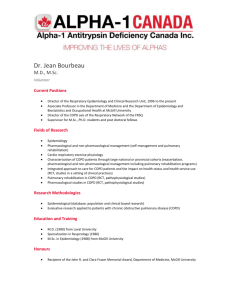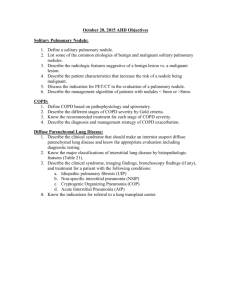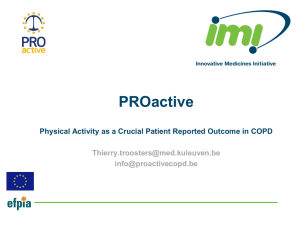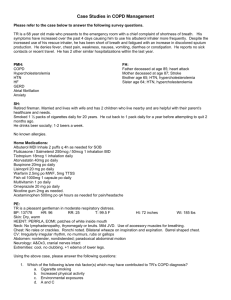ERS/ATS COPD Guidelines: CME accreditation - ERS e
advertisement
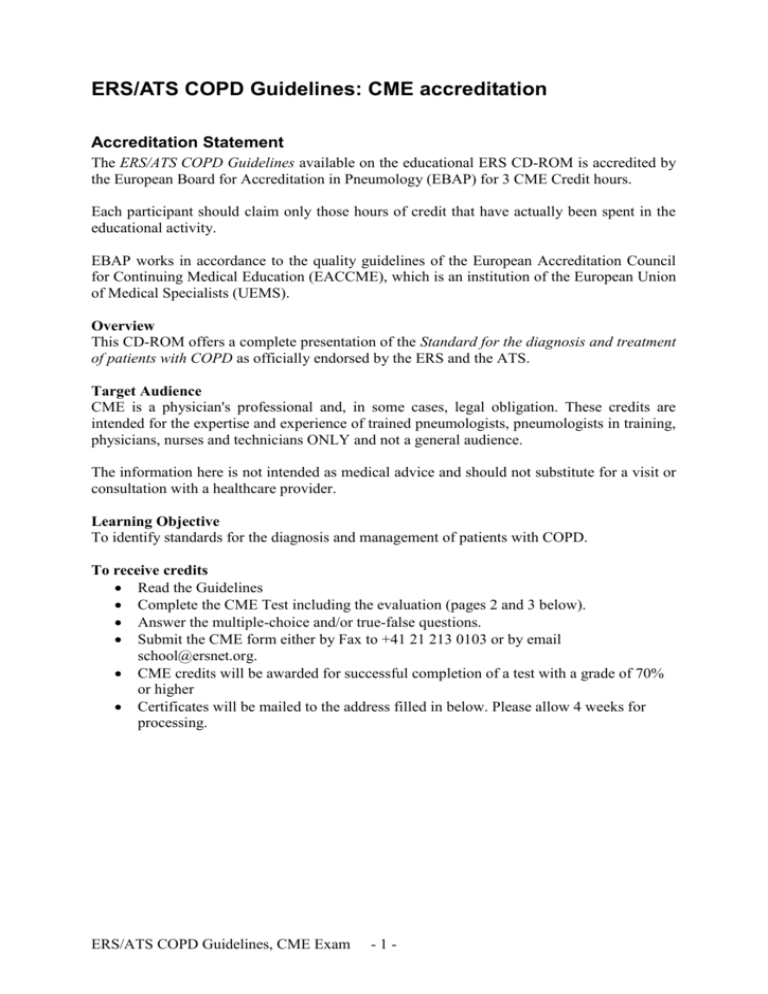
ERS/ATS COPD Guidelines: CME accreditation Accreditation Statement The ERS/ATS COPD Guidelines available on the educational ERS CD-ROM is accredited by the European Board for Accreditation in Pneumology (EBAP) for 3 CME Credit hours. Each participant should claim only those hours of credit that have actually been spent in the educational activity. EBAP works in accordance to the quality guidelines of the European Accreditation Council for Continuing Medical Education (EACCME), which is an institution of the European Union of Medical Specialists (UEMS). Overview This CD-ROM offers a complete presentation of the Standard for the diagnosis and treatment of patients with COPD as officially endorsed by the ERS and the ATS. Target Audience CME is a physician's professional and, in some cases, legal obligation. These credits are intended for the expertise and experience of trained pneumologists, pneumologists in training, physicians, nurses and technicians ONLY and not a general audience. The information here is not intended as medical advice and should not substitute for a visit or consultation with a healthcare provider. Learning Objective To identify standards for the diagnosis and management of patients with COPD. To receive credits Read the Guidelines Complete the CME Test including the evaluation (pages 2 and 3 below). Answer the multiple-choice and/or true-false questions. Submit the CME form either by Fax to +41 21 213 0103 or by email school@ersnet.org. CME credits will be awarded for successful completion of a test with a grade of 70% or higher Certificates will be mailed to the address filled in below. Please allow 4 weeks for processing. ERS/ATS COPD Guidelines, CME Exam -1- CME Exam and Programme Evaluation (3 CME credits) Applicant personal details ERS Membership N° (if known) . . . . . . . . . . . . . . . . . . . . . . Date of Birth (DD/MM/YYYY) . . . . . . . . . . . . . . . . . . . . . . . Family Name . . . . . . . . . . . . . . . . . . . . . . . . . . . . . . . . . . . First Name . . . . . . . . . . . . . . . . . . . . . . . . . . . . . . . . . . . Mailing Address . . . . . . . . . . . . . . . . . . . . . . . . . . . . . . . . . . . . . . . . . . . . . . . . . . . . . . . . . . . . . . . . . . . . . . . . . . . . Postal Code . . . . . . . . . . . . . City . . . . . . . . . . . . . . . . . . . . . . . . . . . . . . . Country . . . . . . . . . . . . . . . . . . . Telephone: + . . . . . . . . . . . . . . . . . . . . . . . . . . . . . . . . . . . Fax: + . . . . . . . . . . . . . . . . . . . . . . . . . . . . . . . . . . . . . . E-mail: . . . . . . . . . . . . . . . . . . . . . . . . . . . . . . . . . . . . . . . . . . . . . . . . . . . . . . . . . . . . . . . . . . . . . . . . . . . . . . . . . . . . 1. Please evaluate the course by circling/underlining your response. Excellent Good Fair Poor 4 4 4 4 3 3 3 3 2 2 2 2 1 1 1 1 ......... hour(s) How would you rate the following: Value of these guidelines Relevance to practice Scientific quality Meet educational needs Quality of information Impact on practice Absence of industry bias 4 4 4 4 4 4 4 3 3 3 3 3 3 3 2 2 2 2 2 2 2 1 1 1 1 1 1 1 How would you rate the scientific quality of : ERS/ATS guidelines GOLD guidelines 4 4 3 3 2 2 1 1 How would you rate the relevance to practice of : ERS/ATS guidelines GOLD guidelines 4 4 3 3 2 2 1 1 How would you rate the accessibility of: ERS/ATS guidelines GOLD guidelines 4 4 3 3 2 2 1 1 How would you rate the independence of industry bias in : ERS/ATS guidelines GOLD guidelines 4 4 3 3 2 2 1 1 How would you rate the different sections of this CD-Rom: Guidelines Educational questions Figures Facility of use/Navigation Amount of time I spent reading the guidelines ERS/ATS COPD Guidelines, CME Exam -2- Applicant personal details Family Name . . . . . . . . . . . . . . . . . . . . . . . . . . . . . . . . . . . First Name . . . . . . . . . . . . . . . . . . . . . . . . . . . . . . . . . . . 2. Educational questions: Answer by indicating True or False for each of the following statements. T 1 2 3 4 5 6 7 8 9 10 11 12 13 14 15 16 17 18 19 20 21 22 23 24 25 26 27 28 29 30 31 32 33 34 35 36 37 38 Chronic Bronchitis and COPD are the same condition. Where COPD and asthma do co-exist patients should be managed as asthmatic. An FEV1 >80% predicted rules out a diagnosis of COPD. Spirometry can be used to predict development of exacerbations. Sputum Volume is an important predictor of long term survival in COPD About 90% of subjects with severe COPD have a medical diagnosis of COPD. Alpha-antitrypsin deficiency is a definite host risk factors for COPD An accelerated decline in lung function is the most important feature of COPD. An imbalance of proteinases and antiproteinases in the lungs is important in the pathogenesis of COPD. Centrilobular emphysema predominantly in the lower lobes is one of the pathological changes seen in COPD Dynamic hyperinflation at rest is a pathophysiological abnormality characteristic of COPD Airflow obstruction characteristically worsens even in mild exacerbations. Paradoxical respiratory muscle movement is very characteristic of severe COPD. Pursed lip breathing may be used as a sign of early COPD. Chest radiographs should be performed on all COPD patients Quitting smoking increases lung growth rates in adolescents. Nicotine tablets is a pharmaco-therapy proven effective in smoking cessation Nicotine nasal spray may prolong nicotine dependence. At present no drug treatment has been shown to modify the rate of decline of lung function. Oral corticosteroids are not indicated in stable COPD. Long-acting inhaled beta-agonists (salmeterol, formoterol) increase lung function for at least 12 h in COPD. The increase in FEV1 caused by bronchodilators is usually not accompanied by changes in lung volume. Physiological indications for oxygen therapy include an Sp,O2 <78%. Long-term oxygen therapy has been shown to improve survival in COPD patients if delivered at least 10 h per day Pulmonary rehabilitation is not indicated for current cigarette smokers. Exercise training is an essential component of pulmonary rehabilitation. Patients with COPD are at increased risk of pulmonary neoplasm following surgery There is a 7-fold increased risk of postoperative pulmonary complications. The benefits of LVRS are unquestionable. Lung transplantation is an option for moderate COPD and not severe cases. The prevalence of sleep apnoea in patients with COPD is about the same as a normal population of similar age. Causes of exacerbation can be both infectious and non-infectious. Factors that identify "high risk" patients include one previous emergency room visit within 7 days. Inhaled corticosteroids should be considered. In patients who needed intubations NPPV can be considered as a potential successful strategy for weaning. NPPV is very effective and safe in exacerbations with respiratory acidosis. Most patients want their physicians and surrogates to overrule their written advance directives if unique clinical circumstances occur. Discussions about the end of life should take place when the patient is stable. ERS/ATS COPD Guidelines, CME Exam -3- F






